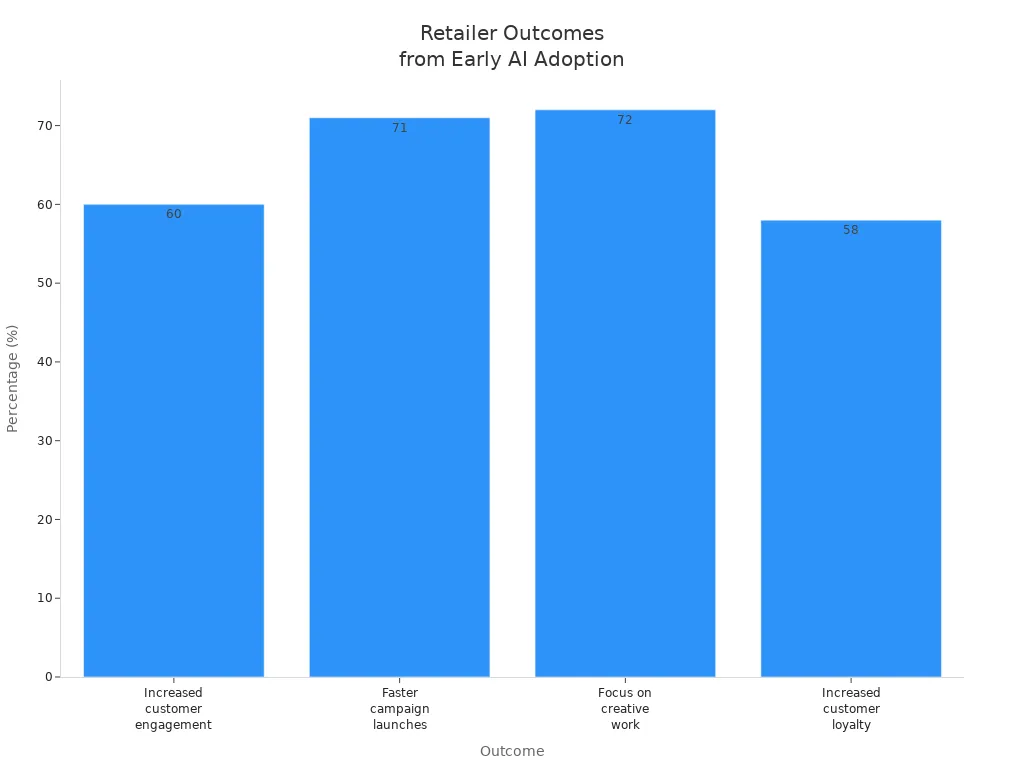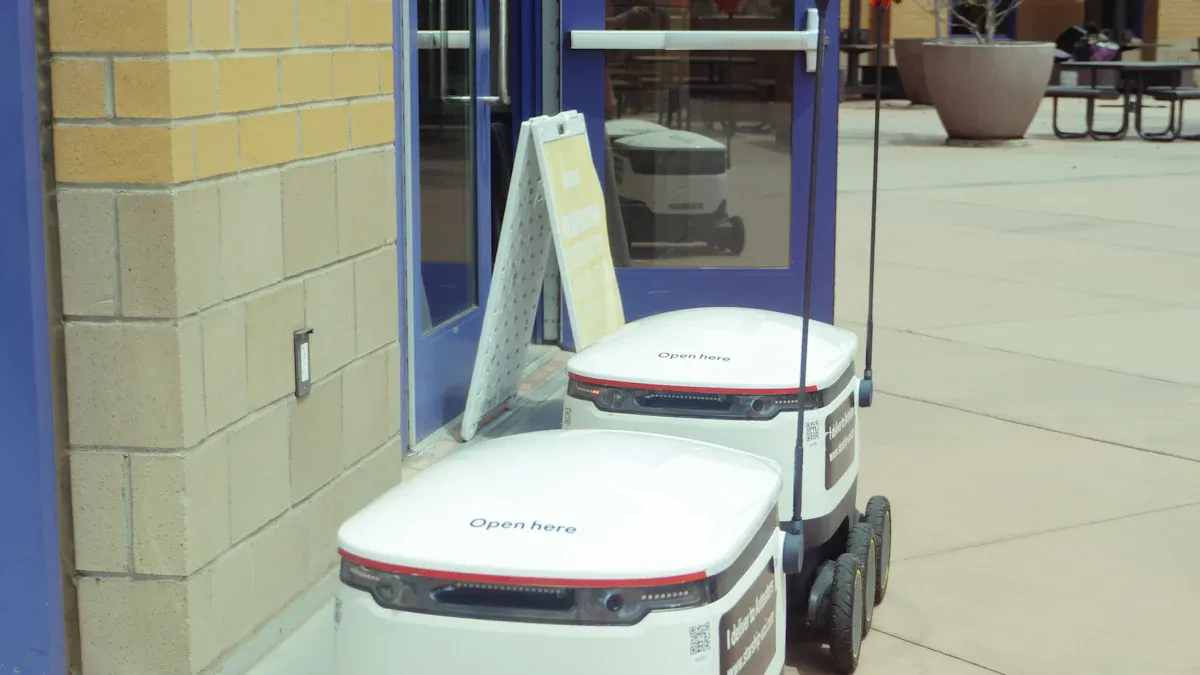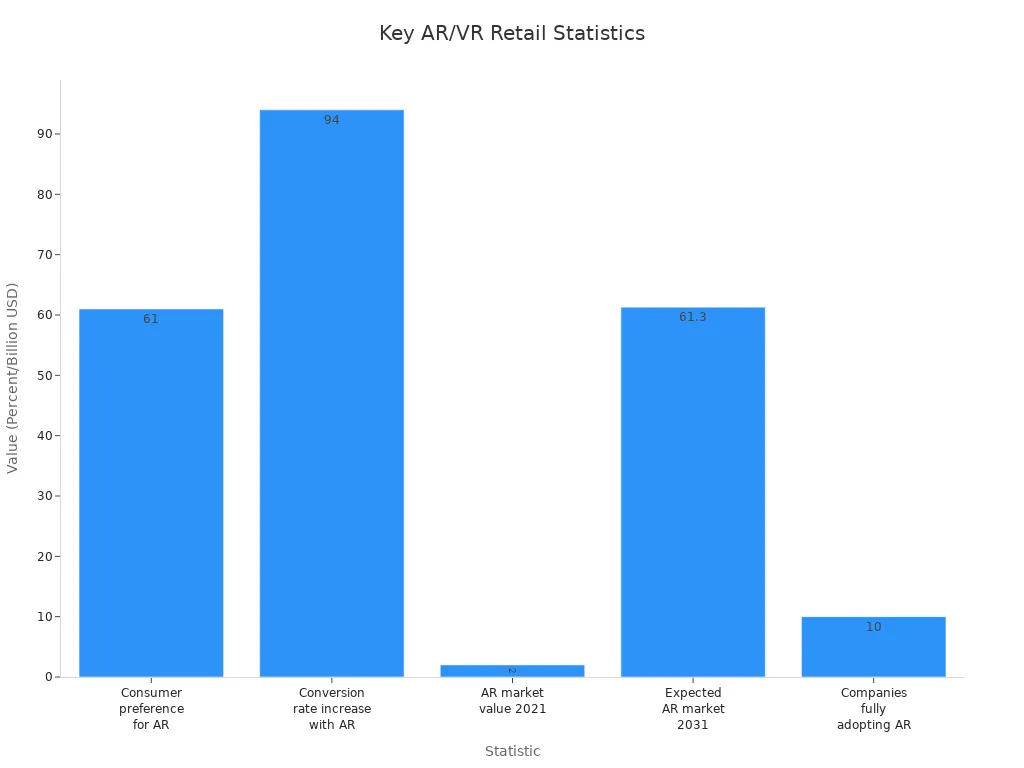AI Stores in 2025

AI Stores in 2025 will change how you shop and how stores work. You will see smart shopping agents, predictive analytics, and generative AI everywhere. Retailers now spend 20% of their tech budgets on ai. When stores use ai chatbots, they see 15% more sales during big events like Black Friday. Smart inventory systems cut overstocking by 18%.
Description | |
|---|---|
Voice and Text Shopping | You can talk or type to smart assistants for fast shopping. |
Visual Search | Snap a picture to find products quickly. |
Smart Inventory Forecasting | Stores avoid empty shelves and wasted stock. |
Dynamic Pricing | Prices change to match real-time demand. |
Fraud Detection | Better security keeps your transactions safe. |
Omnichannel Experiences | Shop online or in-store with the same smooth experience. |
Sustainability Practices | AI helps stores waste less and pollute less. |
Generative AI | Stores create cool ads and designs faster. |
You need to keep up with these ai changes if you want to stay ahead in retail.
Key Takeaways
AI stores will transform shopping with smart assistants that provide personalized recommendations, making your experience smoother and more enjoyable.
Predictive analytics will help retailers keep shelves stocked and reduce waste, ensuring you find your favorite products every time you shop.
Generative AI will enhance marketing efforts, allowing stores to create engaging content quickly and keep you informed about new products and offers.
Dynamic pricing will adjust in real-time, ensuring you get fair prices based on current demand and your shopping habits.
Robotics and automation will streamline operations, leading to fewer empty shelves and faster checkouts, making your shopping trips more efficient.
AI Stores in 2025
Retail Transformation
You walk into a store in 2025, and everything feels different. The transformation in retail is everywhere. You see smart shopping agents ready to help you find what you want. These agents use natural language processing, so you can talk to them just like you talk to a friend. They answer your questions fast and give you personalized recommendations. This shift makes shopping smoother and more fun.
AI stores in 2025 use predictive analytics to make smart decisions. Stores know what products you like and when you want them. They use data to keep shelves stocked and avoid waste. You get better choices, and stores save money. Businesses using predictive analytics can cut inventory costs by up to 30%. They also boost profits by 6% to 8%. Retailers who use these tools stay ahead of the competition.
Generative ai brings even more transformation. Stores create ads and designs quickly. You see new products and offers that match your style. AI-driven product search helps you find what you need fast. Merchandising and demand forecasting get easier, so stores always have the right products.
Here’s how ai stores in 2025 change the game:
Benefit | Description |
|---|---|
AI agents provide personalized recommendations and prompt responses, creating a seamless shopping experience. | |
Automatic data-driven insights | AI analyzes customer data to inform business decisions, identifying trends and preferences. |
Operational efficiency | Automation of routine tasks allows employees to focus on strategic activities, improving overall efficiency. |
You see stores using computer vision to manage inventory and recognize products. This technology makes operations faster and more accurate. Employees spend less time on boring tasks and more time helping you.
Retailers like Walmart lead the way in digital transformation. Walmart uses machine learning for supply chain automation. They build digital twins of their stores to model merchandise movement. Store associates use ai chatbots to answer your questions and solve problems quickly.
"To win in retail, you have to win in tech." - Gary Hawkins, Founder and CEO of the Center for Advancing Retail & Technology
Competitive Advantage
You want to know how ai stores in 2025 help retailers win. The answer is simple: transformation gives them a big edge. Companies that use ai and digital transformation see better results. They launch marketing campaigns faster and focus on creative work. Teams spend less time on repetitive tasks.

Retailers report higher customer engagement and loyalty. You get offers and messages that fit your needs. Stores keep you coming back with personalized experiences. Early adopters like Walmart use ai to optimize inventory and improve customer service. They use digital twins to make sure products are always available.
Here are some ways ai stores in 2025 give retailers a competitive advantage:
Walmart uses machine learning tools for supply chain automation.
Store associates use ai chatbots for better customer service.
Digital twins help model merchandise movement and keep shelves stocked.
By 2025, 20% of top global retailers will drive results using distributed ai systems. Most executives say ai is the top game-changing technology in retail. You see the impact in every part of modern commerce.
Retailers who embrace transformation see big changes:
Outcome | Percentage | Description |
|---|---|---|
Increased customer engagement | 60% | Retailers report higher engagement across channels due to more relevant and personalized communications. |
Faster campaign launches | 71% | AI helps in launching marketing campaigns faster, saving an average of 2.3 hours per campaign. |
Focus on creative work | 72% | AI reduces repetitive tasks, allowing teams to concentrate on strategic and creative efforts. |
Increased customer loyalty | 58% | AI enhances customer retention by delivering the right offers and messages to encourage repeat business. |
You see transformation in every part of ai stores in 2025. Retailers use digital transformation to stay ahead. They use ai to make shopping better for you and more profitable for them.
AI in Retail
Personalization
You notice how ai in retail makes shopping feel like it was made just for you. With ai shopping assistants, you get suggestions that match your style and needs. These smart helpers use ai-powered personalization to learn what you like and show you products you want. You see offers pop up right when you need them. This is hyper-personalization in action.
Personalized recommendations keep you coming back by showing you items you love.
Predictive shopping means ai shopping assistants know what you might need before you even ask.
Generative ai helps stores change offers and recommendations in real time, so you never miss out.
You can chat with virtual shopping assistants or use conversational commerce to ask questions and get instant answers. This makes your shopping experience smooth and fun. With ai-enhanced omnichannel experiences, you get the same great service online and in-store.
Product Discovery
Finding the right product gets easier with ai in retail. You use ai shopping assistants to search for items, and they show you the best matches fast. Hyper-personalization means you see products that fit your taste, not just random picks. Stores use ai to boost product visibility and make listings smarter.
Metric | Improvement |
|---|---|
Search Traffic | 44% |
Search Revenue | 34% |
Revenue per User Session | 27% |
AI shopping assistants help you find what you want quickly.
Personalized recommendations make you happier with your choices.
Shopping feels faster because you spend less time searching.
You also get help from smart shopping assistants who guide you through the store, both online and offline. Conversational commerce lets you ask for help anytime, making product discovery simple.
Dynamic Pricing
Prices change fast in ai in retail. Stores use ai shopping assistants and hyper-personalization to set prices that match your needs and the market. Real-time data and ai help retailers adjust prices in seconds. You see fair prices that reflect what’s happening right now.
Advancement Type | Description |
|---|---|
AI Price Optimization | Stores use advanced algorithms for quick price changes based on many factors. |
Real-Time Data Analytics | Retailers process huge amounts of data instantly for dynamic pricing. |
Hyper-Personalized Pricing | Prices are set just for you, using your shopping habits and preferences. |
Revenue Growth | Dynamic pricing can boost store revenue by up to 10% and cut costs by up to 5%. |
Customer Satisfaction | Personalized pricing can increase sales by up to 15% and make customers 20% happier. |
You expect transparency and fairness in pricing. Retailers use ai-enhanced omnichannel experiences to keep prices clear and build trust. With hyper-personalization, you get deals that feel special to you.
Autonomous Stores

Frictionless Checkout
Imagine walking into a store, grabbing what you want, and leaving without waiting in line. That’s what you get with smart checkout in autonomous stores. These cashierless stores use ai to track your purchases and charge you automatically. You don’t need to pull out your wallet or scan anything. This makes shopping fast and easy.
Check out how frictionless checkout changes your experience:
Evidence Type | Details |
|---|---|
Customer Satisfaction Correlation | Lower satisfaction is linked to longer payment processing times. |
Self-Checkout Adoption Impact | A 10% increase in self-checkout adoption could improve NPS from 34 to 54. |
Checkout Experience Influence | 70% of customers feel checkout experience shapes their view of a store more than anything else. |
Negative Experience Consequence | 79% of customers say a bad checkout makes them less likely to return. |
You see how much checkout matters in retail. When you spend less time waiting, you feel happier and want to come back. Stores also see more sales because people shop more when it’s easy.
Smart Inventory
You never find empty shelves or piles of unsold products in these stores. Smart inventory powered by ai keeps everything just right. The system watches sales and restocks items before they run out. It also moves products between locations to balance stock and avoid waste.
AI systems monitor sales speed and set smart reorder points.
You get a full view of stock across all stores, so you always find what you need.
Smart inventory management predicts demand 40% better than old systems.
It cuts extra stock by up to 30%, saving money and space.
Machine learning finds patterns in sales and adjusts orders in real time.
With smart inventory, retail stores stay ready for anything. You get what you want, and stores waste less.
Store Layout
You notice how easy it is to find things in autonomous stores. That’s because ai helps design the best store layout. The system studies how you move through the store and uses heat maps to see where people go most. This helps stores put popular items in the right spots and make shopping smoother.
Evidence Description | Impact on Customer Flow and Sales |
|---|---|
Enhances satisfaction and drives higher sales. | |
Layout shapes how you shop and what you buy. | Maximizes engagement and revenue. |
Smart layouts mean more sales and bigger purchases. | Leads to sales growth. |
AI-driven layout uses data for better design. | Gives tips on product placement and store setup. |
Ariadne’s visitor flow analytics let stores track your path in real time. They use this data to change layouts and make shopping even better. You get a store that feels made for you, and retail stores see more sales.
Generative AI
Customer Service
You walk into a retail store and feel like someone knows exactly what you need. That’s the magic of generative artificial intelligence in customer service. You get quick answers and helpful advice from smart chatbots. These bots talk to you just like a real person. They understand your questions and give accurate information about products and sales.
Generative ai helps store associates work faster. You see them using tablets or phones to get instant support. This technology makes their jobs easier and lets them focus on you. You get more attention and better service.
Generative ai creates accurate sales and support conversations.
You enjoy individualized experiences that boost your satisfaction.
Personalized interactions make you feel special and build loyalty.
Generative ai acts as a partner for store associates, improving their productivity.
You notice smoother workflows and better customer interactions.
You leave the store feeling happy. You want to come back because the customer experience feels personal and easy.
Content Creation
You see fresh ads, videos, and product descriptions every time you shop. Generative ai powers content creation in retail. You get to read blog posts and product details that match your interests. Stores use tools like Jasper.ai to write catchy product descriptions. Copy.ai helps with social media posts that grab your attention. ChatGPT comes up with new ideas and writes all kinds of content.
You watch videos with human-like voices made by Murf. Synthesia creates videos that show off new products and sales. HubSpot helps stores send marketing emails and social media updates. These tools make content fast and keep it interesting.
Jasper.ai writes blog posts and product descriptions for e-commerce.
Copy.ai creates social media copywriting.
ChatGPT helps with content ideation and writing.
HubSpot offers marketing emails and social media content.
Murf makes human-like voiceovers for videos.
Synthesia lets stores create ai-generated videos for marketing and sales.
You notice that stores always have something new to show you. This keeps you engaged and excited to shop.
Immersive Experiences

AR & VR
You step into a store and see digital magic everywhere. Augmented reality (AR) and virtual reality (VR) let you try on clothes, see furniture in your living room, or test makeup without touching anything. You just point your phone or use a headset. Shopping feels fun and easy. Most shoppers love this tech. In fact, 61% of people prefer AR when they shop. Stores using AR see a huge jump in sales, with conversion rates rising by 94%. You notice fewer returns too, because you know exactly what you’re getting. The AR market in retail was worth $2 billion in 2021, and experts say it will reach $61.3 billion by 2031. Still, less than 10% of companies use AR fully.
Statistic | Value |
|---|---|
Consumer preference for AR in shopping | 61% |
Increase in conversion rates with AR | 94% |
AR market value in retail (2021) | $2 billion |
Expected AR market value by 2031 | $61.3 billion |
Companies fully adopting AR | <10% |

You see stores using AR to boost conversion rates by 90% and cut product returns by 40%. You get to enjoy immersive shopping experiences that make you want to come back.
In-Store Navigation
You walk into a big store and wonder where to find your favorite snacks. AI-driven navigation systems help you right away. You get real-time directions on your phone. The system shows you where products are and gives you tips based on what you like. You spend less time searching and more time shopping.
You get quick help finding products.
Personalized suggestions make shopping easier.
The store feels less crowded because AI manages busy areas.
You see shorter lines at checkout.
Heat maps show where people gather, so staff can help faster.
You always know if something is in stock.
You skip long lines with mobile scan-and-go and even pay with your fingerprint. Shopping feels smooth and fast.
Interactive Demos
You want to try before you buy. Interactive demos powered by AI let you do just that. You step into an AR photobooth and see yourself wearing new sunglasses or a cool jacket. You snap a photo and share it with friends. Stores like Dolce & Gabbana saw thousands of social media posts from shoppers using their AR photobooth. Valentino printed 1,579 branded photos in just two days at their pop-up shop. You feel special because AI personalizes your demo experience. In fact, 81% of shoppers say they want personalized demos.
You get more engaged with products.
Personalized demos make you feel valued.
Stores see better marketing results with more shares and photos.
Tip: Try interactive demos next time you shop. You might discover something new and have fun sharing it!
Robotics & Automation
Stocking
You walk into a store and see shelves that always look full. That’s not magic—it’s robotics and automation at work. Robots now scan shelves and count products several times a day. They spot missing items and send real-time alerts to managers. This means you rarely see empty shelves or wrong prices. Stores using these robots report up to 90% fewer pricing mistakes. Some even see a 60% drop in out-of-stock products. You get what you want, when you want it.
Evidence Description | Impact on Stocking Efficiency |
|---|---|
Robots scan shelves and count products multiple times daily, improving inventory accuracy. | Reduces mistakes and keeps track of every item. |
Robots send real-time data to store managers about out-of-stock situations. | Fewer empty shelves and quicker restocking. |
Robots track inventory levels and send alerts when products run low. | Proactive restocking leads to full shelves more often. |
Stores using inventory robots report up to 90% fewer pricing mistakes. | Enhances overall stocking accuracy and efficiency. |
Some stores see a 60% drop in out-of-stock products. | Increases availability of desired items for customers. |
Tip: Next time you shop, notice how rarely you see empty shelves. That’s the power of smart robots!
Delivery
You want your orders fast and on time. AI-powered delivery systems make that possible. These systems boost efficiency and cut costs for stores. Companies use AI to plan delivery routes, so your package arrives sooner. Predictive analytics help stores know what you’ll order next, so they can prepare ahead. You get fewer delays and more accurate deliveries.
AI increases efficiency and reduces operational costs in e-commerce delivery.
Companies using AI in logistics experience optimized resource allocation and improved customer satisfaction.
AI-driven automation in e-commerce logistics leads to faster deliveries and fewer errors.
Predictive analytics help businesses forecast demand and prevent stockouts, enhancing delivery accuracy.
AI-powered route optimization minimizes delays, adapting to real-time conditions.
You see your package arrive quickly, and stores save money at the same time.
Service Robots
You might meet a robot helper during your next shopping trip. Service robots do more than just look cool—they make your experience better. These robots scan shelves for missing items and fix pricing errors. They guide you to the right aisle and answer your questions. Some robots even let you check out your items, so you skip the line.
Service robots improve inventory management by continuously scanning shelves for out-of-stock items and pricing discrepancies.
They assist customers by guiding them to products and providing information, especially in large retail spaces.
Robotic checkout systems reduce queue times and allow for self-service transactions.
Telepresence robots connect remote customers with in-store associates for personalized assistance.
Data collection from robots offers insights into shopping patterns and customer behavior.
Almost 90% of retail leaders now invest in technology to make your shopping better. Stores like Lowe’s even have the LoweBot, which helps you find products and check inventory. You get faster help, shorter lines, and a smoother shopping trip.
Predictive Analytics
Forecasting
You want your favorite products on the shelf every time you shop. Predictive analytics helps stores make that happen. By studying sales data and shopper habits, stores know what to order and when. This smart forecasting means fewer empty shelves and less wasted stock. You see stores using predictive customer engagement to predict what you’ll buy next. That keeps inventory levels just right.
Take a look at how predictive analytics changes inventory management:
Statistic | Impact |
|---|---|
Result from erroneous replenishing practices or inventory mismanagement | |
30% of customers | Purchase from another store in understock situations |
4% revenue loss | Resulting from abandoned sales due to stockouts |
Stores lose money when they run out of products. You might even shop somewhere else if your favorite item isn’t available. Predictive analytics helps retail stores avoid these problems and keep you happy.
Marketing
You notice how stores send you offers that match your interests. That’s predictive analytics at work. Retailers use predictive customer engagement to study your shopping history and send you deals you actually want. This makes your shopping experience feel personal and fun.
Here’s how predictive analytics boosts marketing in retail:
Benefit | Description |
|---|---|
Data-Driven Decision Making | Reduces guesswork in planning and tracks results. |
Operational Efficiency | Streamlines inventory and staffing, cutting waste. |
Enhanced Customer Experience | Creates personalized shopping journeys and timely offers. |
Risk Management | Warns about issues and helps spot fraud early. |
Stores use predictive search to guess what you’ll look for next.
You get targeted promotions based on your past purchases.
Accurate demand forecasting means fewer out-of-stock items.
Retail predictive analytics helps stores understand what you want and when you want it. You get better deals, and stores see more sales.
Fraud Detection
You want your shopping to be safe. Predictive analytics makes that possible. Retailers use AI-driven systems to spot fraud fast. These systems study huge amounts of data and look for patterns that don’t fit. If something seems off, the system alerts the store right away.
Retailers use AI to fight fraud as online shopping grows.
Smart systems analyze transactions and customer behavior for signs of trouble.
These tools combine data from many sources to catch fraud quickly.
Real-time processing means stores can stop fraud before it causes problems.
You shop with confidence, knowing that predictive analytics keeps your information safe. Retail stores use these tools to protect you and reduce losses.
Strategies for 2025
Adapting to AI
You want your retail business to thrive in 2025. You need to adapt quickly to new AI tools and trends. Start by focusing on what matters most to your customers. Personalization helps you connect with shoppers and boost sales. Smarter search engines make it easier for people to find what they want. Automated content generation saves you time and keeps your product listings fresh. Demand forecasting lets you stock the right items and avoid waste. Dynamic pricing helps you stay competitive and increase profits.
Here’s a quick look at top strategies and their impact:
Strategy | Impact |
|---|---|
Personalization | Companies achieving personalization at scale see 5–15% higher revenue growth. |
Smarter Search | AI-powered search engines improve customer experience, leading to higher conversion rates. |
Automated Content Generation | Generative AI can create and translate product listings in bulk, improving efficiency. |
Demand Forecasting | AI analyzes data to predict demand, optimizing inventory management. |
Dynamic Pricing | AI adjusts prices in real-time, maximizing sales and profitability. |
Big names like Amazon, Walmart, and Sephora already use these strategies. Amazon’s AI-driven personalization increases revenue. Walmart’s smarter search reduces abandoned carts. Sephora builds loyalty with personalized experiences.
Investing in Tech
You need to invest in the right technology to stay ahead in retail. Generative AI helps you improve product catalogs and automate product descriptions. Retailers like Nykaa use AI to review listings faster and with fewer mistakes. Robotics make your store run smoother. Amazon uses over 750,000 robots to save money and boost efficiency. AI-driven analytics help you manage your supply chain and avoid disruptions.
Gartner predicts that agentic AI will make 15% of daily work decisions by 2028. You can also use MACH-based technologies to innovate quickly. Andrew Laudato from The Vitamin Shoppe says these tools help you adapt fast in retail.
Use generative AI for product data and descriptions.
Invest in robotics to improve stocking and delivery.
Adopt AI analytics for better supply chain management.
Try MACH-based technologies for rapid innovation.
Data Privacy
You want your customers to trust your retail brand. Protecting their data is key. Start with clear privacy policies so shoppers know how you use their information. Always ask for user consent before collecting data. Regular reporting shows your commitment to privacy. Teach your customers about their data rights. Build privacy into every AI project from the start.
Here’s a table of important data privacy steps:
Key Component | Description |
|---|---|
Transparency | Implement clear privacy policies to help users understand data practices. |
User Consent Mechanisms | Establish robust mechanisms to ensure individuals are aware of and agree to data usage. |
Regular Reporting | Provide insights into data usage practices to reinforce commitment to privacy. |
Education on Data Rights | Empower users by educating them about their data rights. |
Privacy by Design | Integrate privacy concerns into the development lifecycle of AI technologies. |
Strong Data Governance | Ensure compliance with privacy laws and protect personal data from unauthorized access. |
Training Employees | Train staff on data protection and define roles within the data governance framework. |
Leadership Commitment | Foster a culture of accountability to ensure policies are enforced and sensitive information is protected. |
Train your team to handle data safely. Make sure leaders support strong privacy rules. When you follow these steps, you build trust and keep your retail business safe.
You see AI changing retail in big ways. Smart assistants, predictive analytics, and generative AI make shopping easier and more personal. If you want to stay ahead, you need to use these tools. Looking forward, AI will bring even more changes:
Hyper-personalization gives you unique shopping experiences.
Virtual assistants offer support day and night.
AI boosts efficiency and saves money.
Supply chains become stronger and more reliable.
Now is the time to try these strategies and lead the way in retail.
FAQ
What is an AI store?
An AI store uses smart technology to help you shop. You see robots, chatbots, and digital assistants. These tools make shopping faster and easier. You get personalized offers and quick answers.
How does AI help with product recommendations?
AI studies what you like and what you buy. You get suggestions that match your style and needs. The system learns from your choices and shows you products you might want next.
Will robots replace store workers?
Robots handle boring tasks like stocking shelves and checking prices. You still see people in stores. Workers focus on helping you and making your experience better.
Is my data safe in AI stores?
Stores use strong security to protect your information. You control what data you share. Look for clear privacy policies and ask questions if you feel unsure.
Can I shop without waiting in line?
Yes! Many AI stores offer frictionless checkout. You grab what you need and walk out. The system charges you automatically. You save time and skip the hassle.
See Also
The Future of Retail Lies in AI-Driven Stores
Smart Stores: The Future of Convenient Shopping Experiences
Understanding AI-Enhanced Corner Stores for Modern Retailers
Exploring AI-Enabled Vending Machines for Today's Retail Needs
Transforming Online Retail Management with AI E-Commerce Solutions
